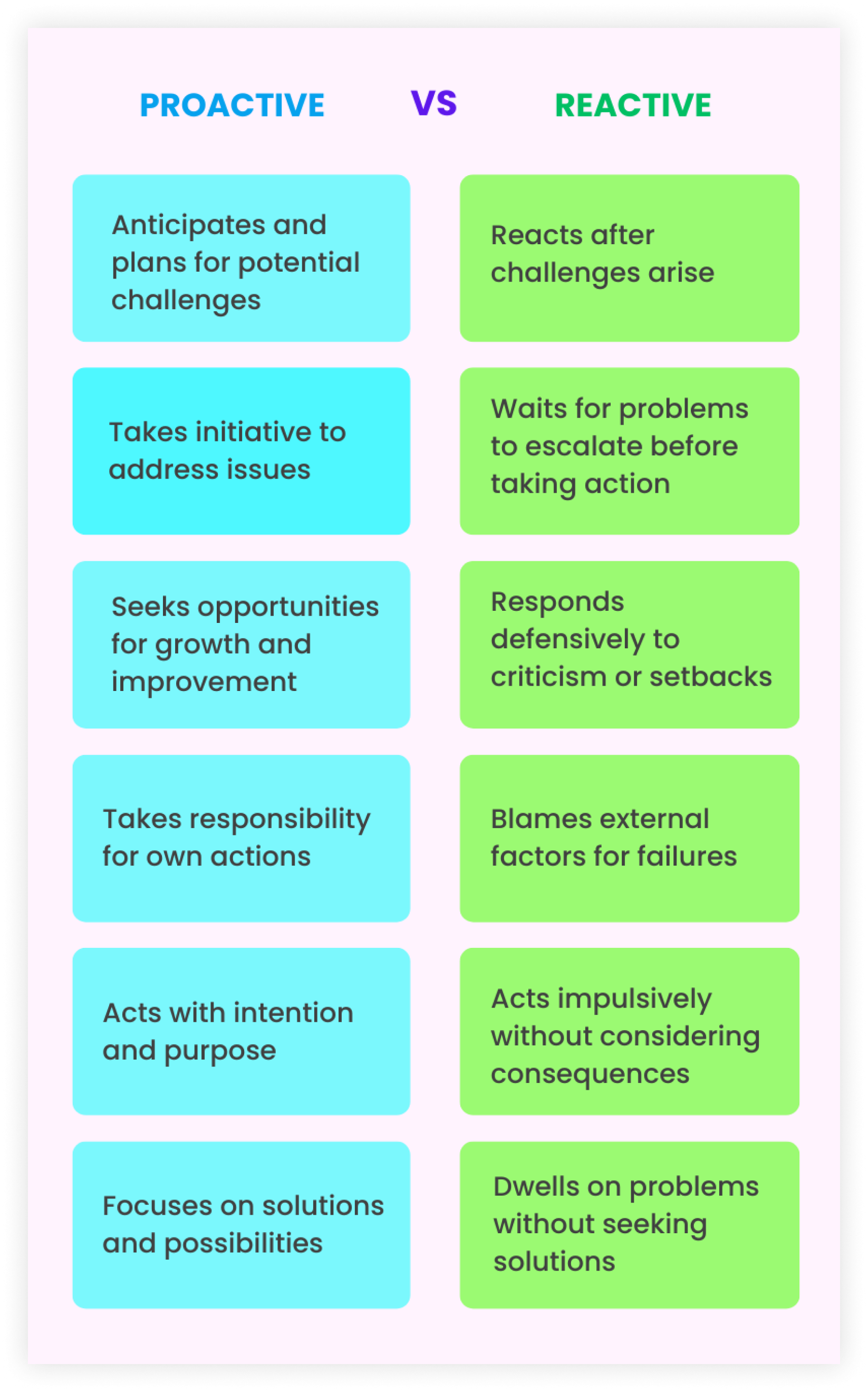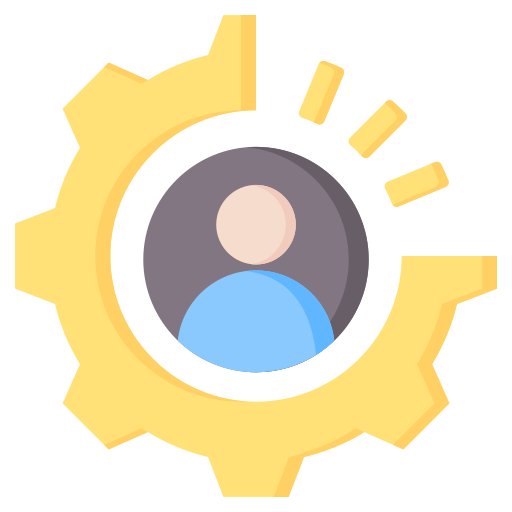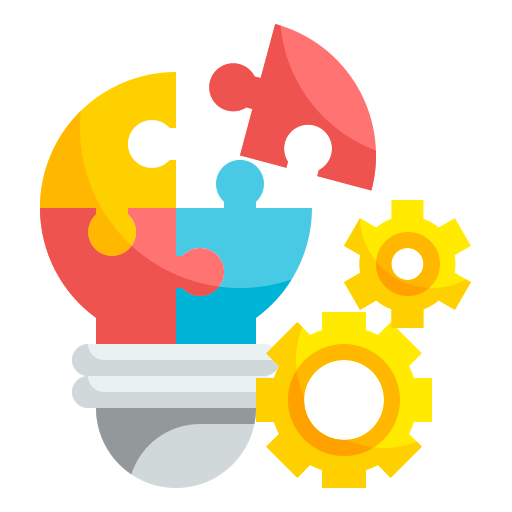Wishing your days had more hours to accomplish everything you want? The answer might lie in a simple yet powerful concept: proactive behavior. Proactive people are the architects of their own success, constantly shaping their lives instead of simply reacting to circumstances.
For being proactive, you must follow and practice some strategies. And in this blog, we’ll explore these strategies for cultivating proactivity in both our career and personal life.
So let’s dive in!
What Does it Mean by Being Proactive?
Being proactive means taking initiative and making things happen rather than waiting for them to occur. The term “active” implies action or doing something, while the prefix “pro-” signifies being prepared or ready beforehand.
At its core, being proactive means taking initiative and responsibility for your own actions and outcomes. In essence, being proactive is about being in control of your own destiny, rather than letting external circumstances dictate your path. It involves anticipating future needs and challenges, and taking preemptive action to address them.
Whether it’s in the workplace, relationships, or personal growth, being proactive empowers you to shape your reality rather than being at the mercy of it.
But perhaps one of the most crucial aspects of proactivity is its relationship with time. Time is the currency of life, and how we choose to spend it. They don’t waste time on little things or get stuck by delaying tasks. Instead, they invest their time wisely, focusing on activities that move them closer to their goals and priorities.
Examples of Proactive Behavior
Proactive behavior can manifest in various aspects of life, from the professional realm to personal relationships and even self-growth. Let’s delve into some examples:

Work
In a professional setting, proactive individuals don’t wait for assignments to come to them; they actively seek out opportunities to contribute and add value to their team or organization. For instance, instead of waiting for their boss to assign them a project, a proactive employee might propose new ideas or solutions to existing problems, demonstrating initiative and leadership qualities.
Moreover, proactive professionals continuously strive to improve their skills and knowledge, seeking out training and development opportunities to stay ahead of the curve in their field.

Relationships
In personal relationships, being proactive means actively nurturing and strengthening the bonds with those around you. Rather than waiting for conflicts to arise, proactive individuals communicate openly and honestly with their loved ones, addressing issues before they escalate into major problems.
Moreover, proactive partners take the initiative to show appreciation and support for their significant others, whether through small gestures of kindness or thoughtful acts of love.

Personal Development
On the path of personal growth and self-improvement, proactiveness is essential. Proactive individuals set clear goals for themselves and take deliberate steps to achieve them, whether it’s pursuing further education, adopting healthier habits, or cultivating new hobbies and interests.
They also take responsibility for their own well-being, prioritizing self-care and mindfulness practices to maintain a healthy balance in their lives.
Being Proactive vs Being Reactive
Being proactive and being reactive represent two contrasting approaches to life. While proactivity involves taking initiative and exerting control over situations, reactivity is characterized by responding to events after they’ve occurred. Let’s look at the key differences between the two.

The Five Ps of Proactiveness
Proactiveness can be broken down into five essential components, often referred to as the Five Ps – Predict, Prevent, Plan, Participate, and Perform. Let’s delve into each one:

Predict
The first step in being proactive is the ability to predict potential challenges or opportunities before they arise. This involves staying alert and attuned to changes in our environment, whether it’s in the workplace, or our personal lives. By anticipating future scenarios, we can better prepare ourselves to respond effectively, minimizing the impact of potential obstacles and maximizing the benefits of emerging opportunities.

Prevent
Once we’ve identified potential challenges or risks through prediction, the next step is to take proactive measures to prevent them from occurring. This could involve implementing safeguards, establishing backup plans, or addressing issues before they have a chance to manifest fully. By being proactive in prevention, we can avoid unnecessary setbacks and maintain a smoother path toward our goals.

Plan
Proactivity is not just about reacting to the present moment; it’s also about planning for the future. Effective planning involves setting clear objectives, outlining strategies to achieve them, and allocating resources wisely. By taking the time to map out our goals and the steps required to reach them, we can navigate obstacles more efficiently and stay on course even when faced with unexpected challenges.

Participate
Actively engaging with our surroundings and taking an active role in shaping our circumstances can help to be proactive. This involves seeking out opportunities for collaboration, networking, and community involvement. By participating actively in our professional and personal spheres, we can expand our horizons, forge meaningful connections, and tap into valuable resources that can further our goals.

Perform
Ultimately, proactiveness is about taking action and following through on our plans and commitments. It’s not enough to simply predict, prevent, plan, and participate; we must also deliver results. This requires discipline, perseverance, and a willingness to adapt in the face of challenges. By consistently performing at our best and striving for excellence in all that we do, we can realize our full potential and achieve the success we desire.
Practical Tips for Implementing the Five Ps
Implementing the Five Ps of Proactiveness in everyday life requires conscious effort and intentionality. Here are some practical tips for incorporating each “P” into your daily routine:
1. Predict

The lack of a Chrome extension might limit its accessibility for some users who prefer browser-based integrations.

Reflect on past experiences to identify recurring patterns or potential obstacles.

Seek input from colleagues, mentors, or trusted advisors to gain different perspectives and insights.
2. Prevent

Conduct risk assessments to identify vulnerabilities and areas of concern.

Develop alternative plans and standard operating procedures.

Deal with issues rather than waiting for problems to escalate.
3. Plan

Define specific, measurable, achievable, relevant, and time-bound (SMART goals) objectives for yourself.

Always prepare backlogs and manage them wisely to make them more attainable.

Utilize calendars, planners, project tracking software, or other workplace tools to help you stay on track.
4. Participate

Join professional associations, networking groups, or volunteer organizations related to your interests or industry.

Cultivate meaningful connections with colleagues, mentors, and peers through active listening, collaboration, and mutual support.

Offer your expertise, insights, and assistance to others in your network.
5. Perform

Start executing your plans and tasks without delay, avoiding procrastination and indecision.

Regularly assess your performance and adjust your approach as needed to stay aligned with your goals.

Acknowledge and celebrate your successes, no matter how small, to maintain motivation and momentum.
By incorporating these practical tips into your daily life, you can harness the power of the Five Ps of Proactiveness to navigate challenges, seize opportunities, and achieve your desired outcomes with confidence and clarity.
How to Be More Proactive in Life
Becoming more proactive in life is a journey of self-awareness, discipline, and intentional action. Here are six tips to help you cultivate a proactive mindset and approach:

Set Clear Goals and Prioritize Tasks
Being proactive starts with clarity of purpose. Set specific goals that align with your values and aspirations. Break down these goals into smaller, actionable tasks, and prioritize them based on urgency and importance.
Statistical Fact
According to a study by Dr. Gail Matthews at Dominican University, people who write down their goals are 42% more likely to achieve them.

Develop a Proactive Mindset
Cultivate a mindset of ownership and accountability. Instead of waiting for opportunities to come to you, actively seek them out. Embrace challenges as opportunities for growth and learning, and maintain a positive attitude even in the face of setbacks.
Statistical Fact
A study published in the Journal of Personality and Social Psychology found that proactive coping strategies are associated with better psychological adjustment and increased life satisfaction.

Take Initiative and Act Promptly
Don’t wait for the perfect moment to take action. Seize opportunities and address challenges head-on. Procrastination is the enemy of proactiveness, so make a habit of taking initiative and following through on your commitments promptly.
Statistical Fact
According to research conducted by psychologist Dr. Piers Steel, procrastination affects up to 95% of people to some degree, leading to decreased productivity and increased stress.

Embrace Continuous Learning and Improvement
Stay curious and open-minded, and actively seek opportunities for personal and professional development. Invest in acquiring new skills, knowledge, and experiences that will expand your capabilities and enhance your effectiveness.
Statistical Fact
As per a report, 74% of adults believe that lifelong learning is essential for keeping up with changes in the workplace and in society.

Anticipate and Prepare for Challenges
Explanation: Proactivity involves being proactive rather than reactive. Anticipate potential obstacles and develop contingency plans to address them. By preparing for challenges in advance, you can minimize their impact and maintain control over your circumstances.
Statistical Fact
Research conducted suggests that individuals who engage in proactive coping strategies experience lower levels of stress and anxiety.

Foster Meaningful Relationships and Networks
Surround yourself with supportive individuals who share your values and goals. Build strong relationships based on trust, collaboration, and mutual respect. Actively participate in professional and social networks to expand your opportunities and access valuable resources.
Statistical Fact
According to research published in the Journal of Experimental Social Psychology, individuals who feel supported by their social networks are more likely to take proactive steps to achieve their goals and overcome obstacles.
By incorporating these six tips into your daily life, you can cultivate a proactive mindset and approach that will empower you to achieve your goals, overcome challenges, and lead a more fulfilling and meaningful life.
How to Be More Proactive at Work
To excel in your career, proactivity is paramount. Take ownership of your projects, seek out opportunities for professional development, and actively contribute innovative ideas to your team.
How to be more proactive at work

Develop your strategic thinking skills

Set SMART goals

Better time management

Develop a growth mindset

Foster Open Communication with your colleagues
Develop Your Strategic Thinking Skills
Proactivity in work begins with strategic thinking. Take the time to assess your current situation, identify your strengths and weaknesses, and envision where you want to be in the future. By developing a strategic plan, you can proactively navigate challenges, seize opportunities, and make progress towards your goals. Embrace a forward-thinking mindset, anticipate potential obstacles, and adapt your strategies as needed to stay on track.
Set SMART Goals
Setting specific, measurable, achievable, relevant, and time-bound (SMART) goals is a fundamental aspect of proactive living. Define what success looks like for you in various areas of your life, whether it’s career advancement, personal growth, health and wellness, or relationships. Break down your goals into actionable steps, and create a timeline for achieving them.
Better Time Management
Effective time management skills are essential for living proactively. Take control of your schedule by prioritizing tasks, you can even use rules like 1-3-5, setting deadlines, and allocating time for both work and leisure activities. Identify time-wasters and distractions, and develop strategies to improve productivity in the workplace. By managing your time effectively, you’ll create more opportunities to pursue your goals, invest in self-care, and engage in activities that bring you joy and fulfillment.
Develop a Growth Mindset
Embrace challenges as opportunities for growth and learning, rather than setbacks or failures. View setbacks as temporary obstacles that can be overcome with effort and perseverance. By adopting a growth mindset, you’ll develop resilience, creativity, and a willingness to step out of your comfort zone to pursue new opportunities and experiences.
Foster Open Communication with Your Colleagues
Take the initiative to express your thoughts, feelings, and needs openly and honestly with others. Listen actively to their perspectives, seek feedback, and collaborate on solutions to mutual challenges. By fostering open communication, you’ll build stronger connections, resolve conflicts more effectively, and create a supportive network that empowers you to thrive.
Pillars of Proactive Learning
To cultivate proactive learning, you must know the pillars of proactive learning. Proactive learning is a transformative approach that empowers individuals to take charge of their educational journey and pursue knowledge with intentionality and enthusiasm. Here are three key pillars of proactive learning:

Curiosity
Curiosity serves as the driving force behind proactive learning. By fostering a genuine interest in learning and exploring new ideas, learners are motivated to delve deeper into subjects, ask questions, and seek out knowledge independently. Curiosity fuels a sense of wonder and excitement, propelling learners towards discovery and innovation.

Adaptability
Being adaptable is one of the main features of a proactive individual. Proactive learners remain flexible and open-minded, willing to adjust their approaches and perspectives as needed to overcome obstacles and achieve their goals. By embracing adaptability, learners can thrive in dynamic environments and capitalize on emerging opportunities for learning and development.

Resourcefulness
Resourcefulness is the ability to effectively utilize available resources to overcome challenges and achieve goals. Proactive learners take initiative in seeking out relevant information, tools, and support systems to enhance their learning experience. Resourceful learners make the most of what is at their disposal like online courses, mentorship networks, accessing educational materials to facilitate their learning journey.
Incorporating these pillars into one’s approach to learning can foster a proactive mindset characterized by curiosity, adaptability, and resourcefulness. By embracing a genuine interest in learning, remaining adaptable in the face of change, and utilizing available resources effectively, individuals can take control of their educational journey and unlock their full potential as lifelong learners.
How to Be Less Reactive
Combat reactive tendencies by practicing mindfulness, cultivating emotional intelligence, and developing resilience in the face of adversity. Pause, assess the situation, and respond thoughtfully rather than impulsively. Other practice include:
1. Be aware of the words you use
2. Plan ahead
3. Prioritize your tasks
4. Learn to problem-solve
5. Take action
6. Learn from past mistakes
Benefits of Being Proactive
The benefits of being proactive are numerous and impactful. Here are some key advantages:

Increased Control
Proactive individuals take charge of their circumstances rather than reacting passively. This empowers them to shape outcomes according to their goals and values.

Greater Efficiency
By anticipating challenges and taking prompt action, proactive individuals can streamline processes and optimize resource allocation, leading to increased productivity and efficiency.

Improved Problem-Solving
Proactivity fosters a proactive mindset, enabling individuals to identify and address issues before they become worse. This proactive approach to problem-solving promotes innovation and resilience.

Enhanced Time Management
Proactive individuals keep backlogs based on their importance and urgency, allowing them to allocate time effectively and focus on activities that align with their objectives.

Better Decision-Making
Proactivity involves gathering information, considering potential outcomes, and making informed choices. This proactive decision-making process minimizes the likelihood of impulsive or reactive decisions.

Reduced Stress
Anticipating and addressing challenges in advance can mitigate stress levels by preventing crises and minimizing the impact of unexpected events. Proactive individuals tend to feel more in control of their circumstances, leading to reduced anxiety.

Continuous Improvement
Proactivity encourages self-reflection and learning from past experiences, enabling individuals to adapt and grow over time. By actively seeking opportunities for development, proactive individuals can continuously improve their skills and performance.

Enhanced Relationships
Proactive communication and problem-solving foster positive relationships with colleagues, clients, and stakeholders. Proactive individuals demonstrate reliability, responsiveness, and a commitment to mutual success, which strengthens interpersonal connections.
Overall, embracing proactivity not only yields immediate benefits but also fosters personal and professional growth, resilience, and success in the long term.
Conclusion
Mastering the art of proactiveness is essential for achieving success and fulfillment in today’s world. By embracing a proactive mindset and implementing the strategies outlined in this guide, you can take control of your destiny and create a future filled with opportunities for growth and achievement.
FAQ
1How can I cultivate a proactive mindset?
Cultivate curiosity, set clear goals, take initiative, and embrace continuous learning and improvement.
2What are some common barriers to proactiveness, and how can I overcome them?
Fear of failure, procrastination, and lack of motivation are the common barriers to proactiveness. Overcome them by setting achievable goals, breaking tasks into smaller steps, and seeking support from others.
3Can anyone become proactive, or is it an inherent trait?
Proactiveness can be developed through practice and mindset shifts, although some individuals may naturally lean towards it.
4How does proactiveness contribute to personal development?
Proactiveness fosters goal achievement, resilience, adaptability, and continuous growth, leading to enhanced personal development.
5What are some practical techniques for incorporating the Five Ps into daily life?
Plan tasks ahead, prioritize them based on importance and urgency, set SMART goals, take initiative, and maintain a positive attitude.
6How can I measure my progress in becoming more proactive?
Track your goal achievement, reflect on your actions and decisions, seek feedback, and observe improvements in your productivity and problem-solving abilities.
















